Study on the Effect of Initial Delamination on Tensile Behavior of Offshore Wind Turbine Blade Spar Cap
Abstract
1. Introduction
2. Experimental Study of Initial Delamination
2.1. Delamintion Damage of Blade Spar Cap
2.2. Specimen Design and Test Process
2.3. Experimental Results and Disscussion
3. Numerical Analysis
3.1. Intralaminar Damage Model
3.2. Interlaminar Damage Model
3.3. Finite Element Model
3.4. Modeling Results and Discussion
4. Simulation and Prediction of Blade Laminate with Delamination
4.1. Influence of Delamination Size
4.2. Influence of Delamination Depth
5. Conclusions
- On the basis of comparison with the experimental results, the three-dimensional solid numerical model and progressive failure criterion used in this paper were able to effectively simulate and predict the progressive intralaminar and interlaminar damage process of composite laminates under tensile load, and the structural damage behavior was more comprehensive and detailed. The load–displacement distribution trend of the numerical simulation was consistent with that of the tests, and the overall failure load deviation was less than 6%.
- The main failure modes of laminates with initial delamination under tensile load were matrix tensile failure and interlaminar delamination damage. Initial delamination aggravated the stress transfer and caused the periphery to bear part of the load, leading to local fiber failure.
- For initial delamination at the same depths, differences in delamination area had little influence on tensile strength. The most dangerous locations of delamination were at the shallow surface and at the ratio of 0.3–0.4 in the thickness direction, and the maximum decrease in tensile strength was 14.86%. The delamination at the middle surface had no significant effect on tensile strength.
Author Contributions
Funding
Data Availability Statement
Acknowledgments
Conflicts of Interest
References
- Sun, X.; Huang, D.; Wu, G. The current state of offshore wind energy technology development. Energy 2012, 41, 298–312. [Google Scholar] [CrossRef]
- Ren, Z.; Verma, A.S.; Li, Y.; Teuwen, J.J.; Jiang, Z. Offshore wind turbine operations and maintenance: A state-of-the-art review. Renew. Sustain. Energy Rev. 2021, 144, 110886. [Google Scholar] [CrossRef]
- Chen, C.-H.; Su, N.-J. Global Trends and Characteristics of Offshore Wind Farm Research over the Past Three Decades: A Bibliometric Analysis. J. Mar. Sci. Eng. 2022, 10, 1339. [Google Scholar] [CrossRef]
- Mishnaevsky, L.; Branner, K.; Petersen, N.H.; Justine Beauson, J.; McGugan, M.; Sørensen, B.F. Materials for Wind Turbine Blades: An Overview. Materials 2017, 10, 1285. [Google Scholar] [CrossRef] [PubMed]
- Zhang, X.Y.; Zhou, B.; Li, H.; Xin, W. Depth detection of spar cap defects in large-scale wind turbine blades based on a 3D heat conduction model using step heating infrared thermography. Meas. Sci. Technol. 2022, 33, 055008. [Google Scholar] [CrossRef]
- Nelson, J.W.; Cairns, D.S.; Riddle, T.W. Manufacturing defects common to composite wind turbine blades: Effects of defects. In Proceedings of the 52nd AIAA/ASME/ASCE/AHS/ASC Structures, Structural Dynamics and Materials Conference, Denver, CO, USA, 4–7 April 2011. [Google Scholar] [CrossRef]
- Shohag, M.A.; Hamme, E.C.; Olawale, D.O.; Okoli, O. Damage mitigation techniques in wind turbine blades: A review. Wind Eng. 2017, 41, 185–210. [Google Scholar] [CrossRef]
- Yang, G.S. Damage Mechanics and Damage of Composite Materials; National Defense Industry Press: Beijing, China, 1995. (In Chinese) [Google Scholar]
- Ciang, C.C.; Lee, J.-R.; Bang, H.-J. Structural health monitoring for a wind turbine system: A review of damage detection methods. Meas. Sci. Technol. 2008, 19, 122001. Available online: https://iopscience.iop.org/article/10.1088/0957-0233/19/12/122001 (accessed on 13 October 2008). [CrossRef]
- Branner, K.; Ghadirian, A. Database about Blade Faults; DTU Wind Energy E, No. 0067; DTU Wind Energy: Roskilde, Denmark, 2014; Available online: https://backend.orbit.dtu.dk/ws/portalfiles/portal/118222161/Database_about_blade_faults.pdf (accessed on 1 December 2014).
- Chen, X.; Zhao, W.; Zhao, X.L.; Xu, J.Z. Preliminary failure investigation of a 52.3 m glass/epoxy composite wind turbine blade. Eng. Fail. Anal. 2014, 44, 345–350. [Google Scholar] [CrossRef]
- Overgaard, L.C.T.; Lund, E.; Thomsen, O.T. Structural collapse of a wind turbine blade. Part A: Static test and equivalent single layered models. Compos. Part A 2010, 41, 257–270. [Google Scholar] [CrossRef]
- Haselbach, P.U.; Bitsche, R.D.; Branner, K. The effect of delaminations on local buckling in wind turbine blades. Renew. Energy 2016, 85, 295–305. [Google Scholar] [CrossRef]
- Li, J.; Wang, J.; Zhang, L.; Huang, X.; Yu, Y. Study on the Effect of Different Delamination Defects on Buckling Behavior of Spar Cap in Wind Turbine Blade. Adv. Mater. Sci. Eng. 2020, 2020, 6979636. [Google Scholar] [CrossRef]
- Fu, H.M.; Zhang, Y.B. On the distribution of delamination in composite structures and compressive strength prediction for laminates with embedded delaminations. Appl. Compos. Mater. 2011, 18, 253–269. [Google Scholar] [CrossRef]
- Amaro, A.M.; Reis, P.N.B.; de Moura, M.F.S.F. Delamination effect on bending behaviour in carbon–epoxy composites. Strain 2011, 47, 203–208. [Google Scholar] [CrossRef]
- Zhe, L.A.; Pl, B.; Ns, C. Effect of delamination on the flexural response of [+45/45/0]2s carbon fibre reinforced polymer laminates. Compos. Struct. 2019, 209, 93–102. [Google Scholar] [CrossRef]
- Barenblatt, G.I. The mathematical theory of equilibrium cracks in brittle fracture. Adv. Appl. Mech. 1962, 7, 55–129. [Google Scholar] [CrossRef]
- Overgaard, L.C.T.; Lund, E. Structural collapse of a wind turbine blade. Part B Progressive interlaminar failure models. Composites Part A Appl. Sci. Manuf. 2010, 41, 271–283. [Google Scholar] [CrossRef]
- Mandell, J.F.; Cairns, D.S.; Samborsky, D.D.; Morehead, R.B.; Haugen, D.J. Prediction of Delamination in Wind Turbine Blade Structural Details. J. Sol. Energy Eng. Trans. ASME 2003, 125, 522–530. [Google Scholar] [CrossRef]
- Ye, Q.; Chen, P.H. Prediction of the cohesive strength for numerically simulating composite delamination via CZM-based FEM. Compos. Part B-Eng. 2011, 42, 1076–1083. [Google Scholar] [CrossRef]
- Nelson, J.-W.; Riddle, T.W.; Cairns, D.-S. Effects of defects in composite wind turbine blades—Part 2: Progressive damage modeling of fiberglass-reinforced epoxy composites with manufacturing-induced waves. Wind Energ. Sci. 2017, 2, 653–669. [Google Scholar] [CrossRef]
- Zhao, L.B.; Gong, Y.; Zhang, J.Y. A survey on delamination growth behavior in fiber reinforced composite laminates. Acta Aeronaut. Astronaut. Sin. 2019, 40, 171–199. Available online: https://hkxb.buaa.edu.cn/EN/10.7527/S1000-6893.2018.22509 (accessed on 13 October 2018).
- Sleight, D.W. Progressive Failure Analysis Methodology for Composite Laminated Structural. NASA/TP-1999-209107, 1 March 1999. Available online: http://ntrs.nasa.gov/citations/19990052628 (accessed on 6 September 2013).
- Santos, F.; Teixeira, A.; Guedes Soares, C. Assessing progressive failure in long wind turbine blades under quasi-static and cyclic loads. Renew. Energy 2018, 219, 754–766. [Google Scholar] [CrossRef]
- Verma, A.S.; Vedvik, N.P.; Haselbach, P.U.; Gao, Z.; Jiang, Z. Comparison of numerical modelling techniques for impact investigation on a wind turbine blade. Compos. Struct. 2019, 209, 856–878. [Google Scholar] [CrossRef]
- Yang, R.; He, Y.; Mandelis, A.; Wang, N.; Wu, X.; Huang, S. Induction infrared thermography and thermal-wave-radar analysis for imaging inspection and diagnosis of blade composites. IEEE Trans. Ind. Inform. 2018, 14, 5637–5647. [Google Scholar] [CrossRef]
- Manohar, A.; Lanza di Scalea, F. Detection of defects in wind turbine composite blades using statistically enhanced Lock-In Thermography. Struct. Health Monit. 2013, 12, 566–574. [Google Scholar] [CrossRef]
- Det Norske Veritas. DNVGL-ST-0376. Rotor Blades for Wind Turbines. 2015. Available online: https://rules.dnvgl.com/docs/pdf/DNVGL/ST/2015-12/DNVGL-ST-0376.pdf (accessed on 1 December 2015).
- Hashin, Z. Failure Criteria for Unidirectional Fiber Composites. J. Appl. Mech. 1980, 47, 329–334. [Google Scholar] [CrossRef]
- Camanho, P.P.; Matthews, F.L. A progressive damage model for mechanically fastened joints in composite laminates. J. Compos. Mater. 1999, 24, 2248–2280. [Google Scholar] [CrossRef]
- Richefeu, V.; Chrysochoos, A.; Huon, V.; Monerie, Y.; Peyroux, R.; Wattrisse, B. Toward local identification of cohesive zone models using digital image correlation. Eur. J. Mech. A Solids 2012, 34, 38–51. [Google Scholar] [CrossRef]
- Shokrieh, M.; Zeinedini, A.; Ghoreishi, S. On the mixed mode I/II delamination R-curve of E-glass/epoxy laminated composites. Compos. Struct. 2017, 171, 19–31. [Google Scholar] [CrossRef]
- Camanho, P.P.; Dávila, C.G. Mixed-Mode Decohesion Finite Elements for the Simulation of Delamination in Composite Materials; NASA: Washington, DC, USA, 2002. [Google Scholar]



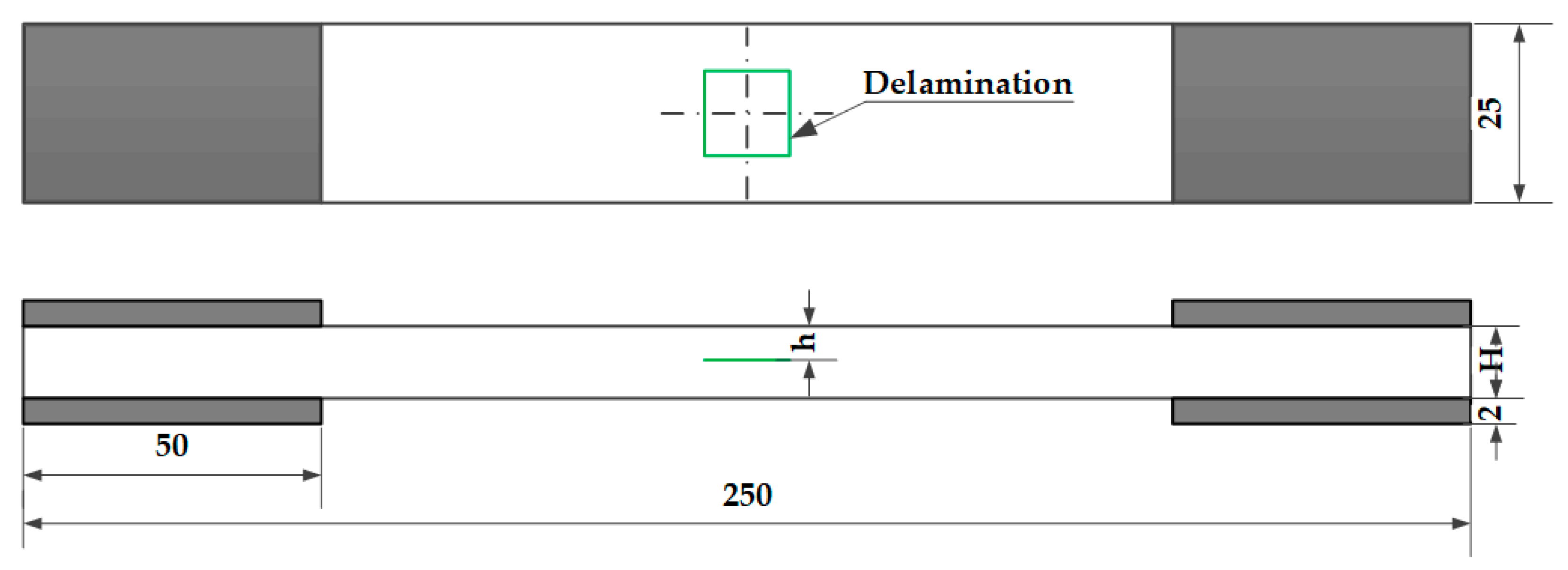

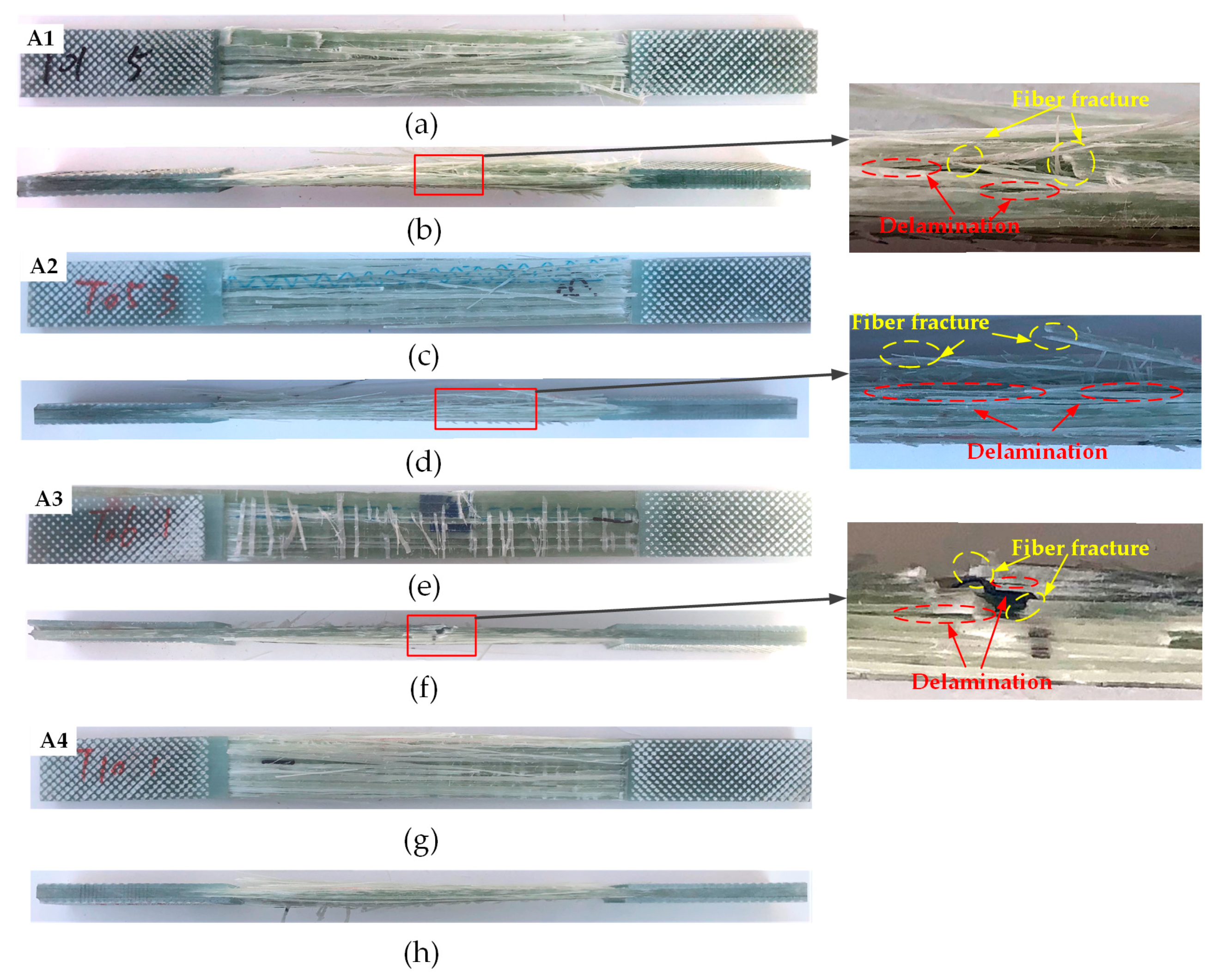
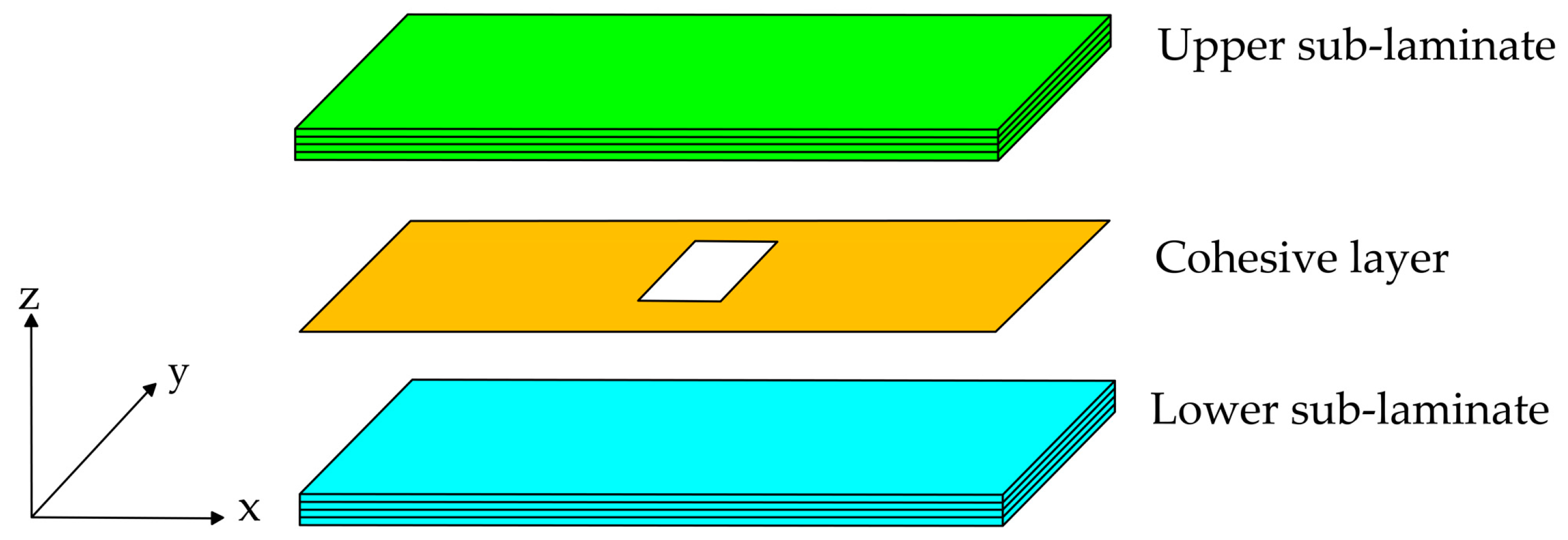
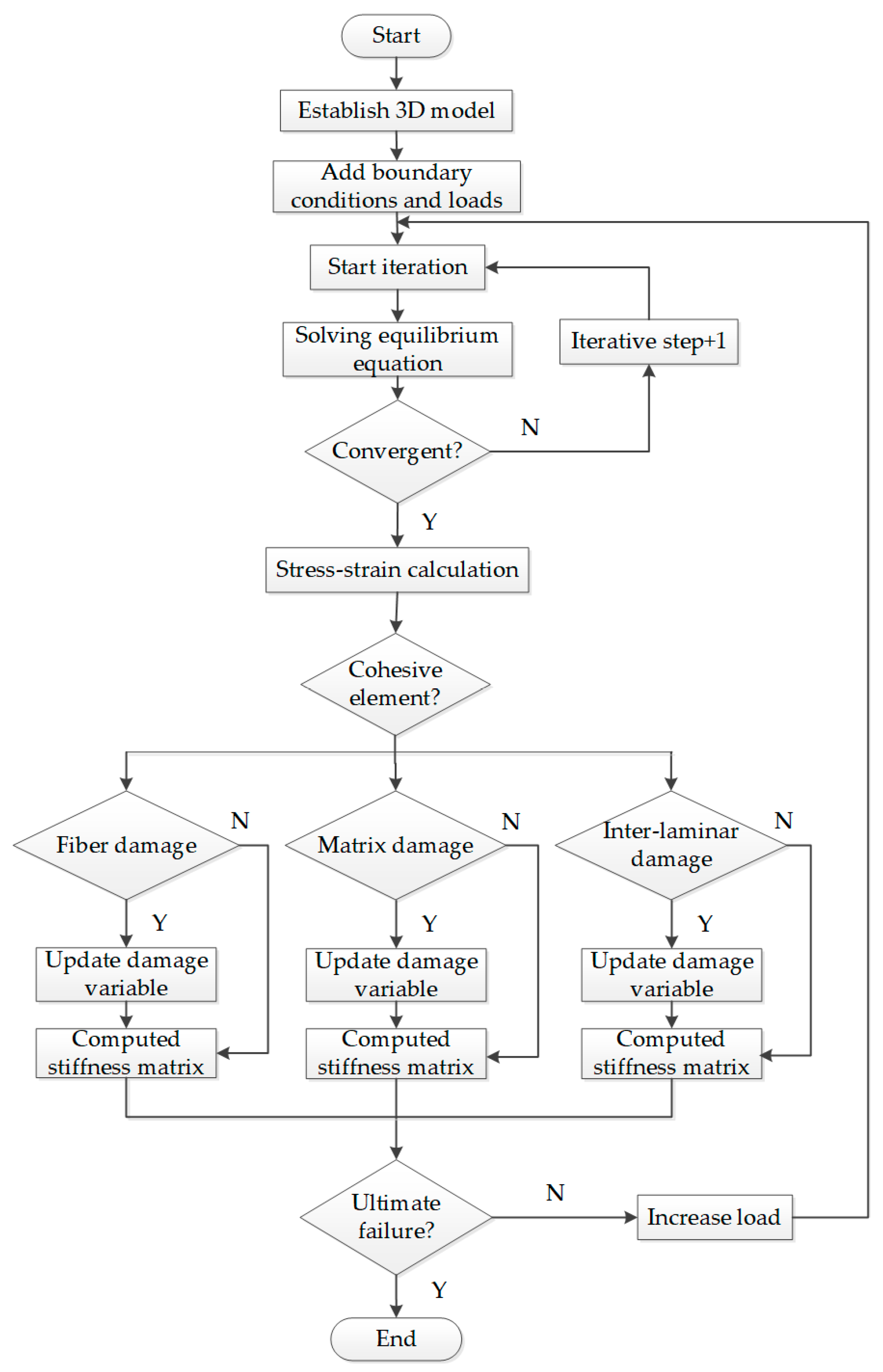





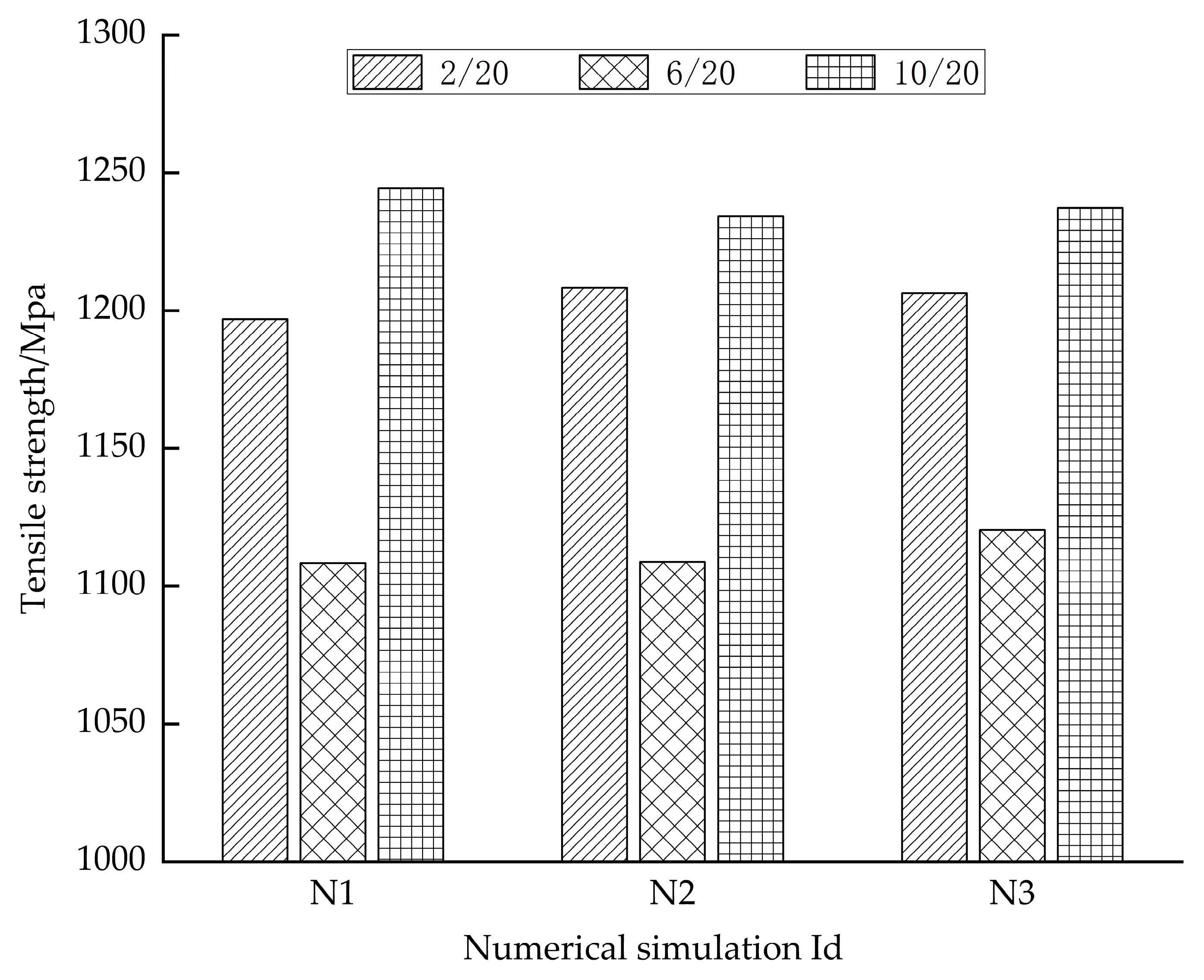


| Marked ID | Delamination Area (mm) | Delamination Position h/H | Number of Specimens |
|---|---|---|---|
| A1 | 10 × 10 | 1/4 | 5 |
| A2 | 15 × 15 | 1/4 | 5 |
| A3 | 15 × 15 | 1/2 | 5 |
| A4 | None | None | 5 |
| Marked ID | Tensile Load (Kn) | Tensile Strength (Mpa) | Thick-Ness (mm) | Width (mm) | Mean Tensile Load (kN) | Dispersion Coefficient (%) | Effective Sample Quantity | Tensile Load Loss Rate (%) |
|---|---|---|---|---|---|---|---|---|
| A1-1 | 107.692 | 1273 | 3.380 | 25.037 | 108.93 | 0.85 | 4 | 2.74 |
| A1-2 | 108.83 | 1292 | 3.327 | 25.310 | ||||
| A1-3 | 109.115 | 1285 | 3.350 | 25.357 | ||||
| A1-4 | 110.074 | 1303 | 3.353 | 25.200 | ||||
| A2-1 | 102.989 | 1202 | 3.390 | 25.280 | 107.11 | 0.32 | 5 | 4.79 |
| A2-2 | 101.822 | 1181 | 3.390 | 25.423 | ||||
| A2-3 | 108.384 | 1281 | 3.387 | 24.987 | ||||
| A2-4 | 110.268 | 1278 | 3.397 | 25.400 | ||||
| A2-5 | 112.102 | 1293 | 3.433 | 25.257 | ||||
| A3-1 | 92.903 | 1163 | 3.403 | 23.467 | 99.4 | 0.74 | 5 | 11.25 |
| A3-2 | 99.819 | 1166 | 3.350 | 25.550 | ||||
| A3-3 | 101.253 | 1151 | 3.450 | 25.500 | ||||
| A3-4 | 101.261 | 1172 | 3.443 | 25.090 | ||||
| A3-5 | 101.848 | 1176 | 3.433 | 25.223 | ||||
| A4-1 | 110.834 | 1290 | 3.407 | 25.227 | 112 | 1.53 | 5 | 0 |
| A4-2 | 111.278 | 1269 | 3.433 | 25.553 | ||||
| A4-3 | 112.166 | 1308 | 3.387 | 25.327 | ||||
| A4-4 | 111.523 | 1299 | 3.370 | 25.477 | ||||
| A4-5 | 114.198 | 1329 | 3.403 | 25.247 |
| Failure Mode | Rules for Reduction of Materials |
|---|---|
| Fiber tensile | |
| Fiber compression | |
| Matrix tensile | , , |
| Matrix compression | , , |
| Ply Properties | Interface Properties [23] | ||
|---|---|---|---|
| 48.8 GPa | 0.368 kJ/m2 | ||
| 13.6 GPa | 0.702 kJ/m2 | ||
| 4.33 Gpa 4.5 Gpa | 20.02 MPa 28.73 MPa | ||
| 0.26 0.3 | 28.73 MPa 2 | ||
| 1207 MPa | |||
| 918.3 MPa | |||
| 46.6 MPa | |||
| 154.1 MPa | |||
| == | 66.5 MPa | ||
| Marked ID | Delamination Area (mm) | Delamination Position h/H | Mean Ultimate Tensile Load (kN) | Simulated Limit Load (kN) | Error Rate (%) |
|---|---|---|---|---|---|
| A1 | 10 × 10 | 1/4 | 108.93 | 104.9 | −3.7 |
| A2 | 15 × 15 | 1/4 | 107.11 | 101.3 | −5.42 |
| A3 | 15 × 15 | 1/2 | 99.4 | 97.9 | −1.5 |
| A4 | None | None | 112 | 108.2 | −3.39 |
| Group | Marked ID | Delamination Area (mm) | Delamination Position h/H | Tensile Strength (Mpa) | Tensile Strength Loss Rate (%) |
|---|---|---|---|---|---|
| N1 | N1-2 | 2/20 | 1196.9 | 3.75 | |
| N1-6 | 40 × 40 | 6/20 | 1108.36 | 10.87 | |
| N1-10 | 10/20 | 1244.34 | −0.06 | ||
| N2 | N2-2 | 2/20 | 1208.37 | 2.83 | |
| N2-6 | 80 × 80 | 6/20 | 1108.74 | 10.84 | |
| N2-10 | 10/20 | 1234.21 | 0.75 | ||
| N3 | N3-2 | 2/20 | 1206.37 | 2.99 | |
| N3-6 | 100 × 100 | 6/20 | 1120.4 | 9.90 | |
| N3-10 | 10/20 | 1237.3 | 0.50 | ||
| N4 | N4 | None | None | 1243.57 | 0 |
Disclaimer/Publisher’s Note: The statements, opinions and data contained in all publications are solely those of the individual author(s) and contributor(s) and not of MDPI and/or the editor(s). MDPI and/or the editor(s) disclaim responsibility for any injury to people or property resulting from any ideas, methods, instructions or products referred to in the content. |
© 2023 by the authors. Licensee MDPI, Basel, Switzerland. This article is an open access article distributed under the terms and conditions of the Creative Commons Attribution (CC BY) license (https://creativecommons.org/licenses/by/4.0/).
Share and Cite
Xin, W.; Li, H.; Lu, X.; Zhou, B. Study on the Effect of Initial Delamination on Tensile Behavior of Offshore Wind Turbine Blade Spar Cap. Energies 2023, 16, 3607. https://doi.org/10.3390/en16083607
Xin W, Li H, Lu X, Zhou B. Study on the Effect of Initial Delamination on Tensile Behavior of Offshore Wind Turbine Blade Spar Cap. Energies. 2023; 16(8):3607. https://doi.org/10.3390/en16083607
Chicago/Turabian StyleXin, Wen, Hui Li, Xiaolong Lu, and Bo Zhou. 2023. "Study on the Effect of Initial Delamination on Tensile Behavior of Offshore Wind Turbine Blade Spar Cap" Energies 16, no. 8: 3607. https://doi.org/10.3390/en16083607
APA StyleXin, W., Li, H., Lu, X., & Zhou, B. (2023). Study on the Effect of Initial Delamination on Tensile Behavior of Offshore Wind Turbine Blade Spar Cap. Energies, 16(8), 3607. https://doi.org/10.3390/en16083607






